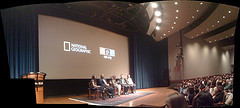 My husband and I attended a lecture recently about digital storytelling. (Having this sort of thing local almost makes dealing with Washington, DC traffic worth it.) The speakers represented two extraordinary storytelling organizations: National Public Radio and the National Geographic Society.
My husband and I attended a lecture recently about digital storytelling. (Having this sort of thing local almost makes dealing with Washington, DC traffic worth it.) The speakers represented two extraordinary storytelling organizations: National Public Radio and the National Geographic Society.
Honestly. If any two groups can do this stuff, it's got to be them. Right?
Well, yeah... kinda.
I typically walk out of these lectures a little disappointed. I don't think it's because I'm jaded... quite the opposite. I am an eternal optimist. I keep thinking surely someone has figured this stuff out so the rest of us don't have to just keep...
...guessing....
As of last night, nobody's got it figured out. These two groups have lucked into some success. I'd wager the success is based more on the brand awareness and audience built over decades than any social media effort to date. That said, it was a very interesting evening filled with beautiful pictures projected 20 feet high and some interesting thoughts and insights about how to use multimedia to tell a story.
The current model seems to be one key story complemented by side stories, using different kinds of multimedia, to either give broader context to the key story or to dive deeper into detail. By doing that, you can actually get enough value added to your storytelling to justify the effort.
There's a lot of effort involved.
Andrea Hsu is a producer for All Things Considered on NPR. She described how, on top of thinking about the details of getting the best possible audio for All Things Considered, she was now carrying around a camera and looking at her situation for opportunities to take good photos. Keith Jenkins, also of NPR, said that the photographers he manages are encouraged to learn about audio and collect that as well (though he didn't exactly say they are actually doing that on a daily basis).
So I'm thinking about this as I'm driving up 16th Street, avoiding the crazy cab drivers and random pedestrians walking in the middle of the street. So you've got people working at NPR who are very good at their jobs. People who are very good at their jobs keep a thousand details in their brains... that is what makes them so good. They've also got egos so they'll apply that level of detail to anything they do: writing the story, recording audio, and taking still photos and video.
At what point do their heads just explode?
I've worked in book publishing, print journalism, Web, and television production. Of all of those experiences, the only one that comes close to what it would take to create consistently focused, high quality, robust multimedia is television. Television production assumes a lot of teamwork: writers, graphics people, directors, producers, technicians of many kinds, and "talent".
Television production is ridiculously expensive. Information on the Web wants more and more to be free. Does anyone else see a fundamental problem here?
If nothing else, just figuring out how to make multimedia pay will make your head explode.





